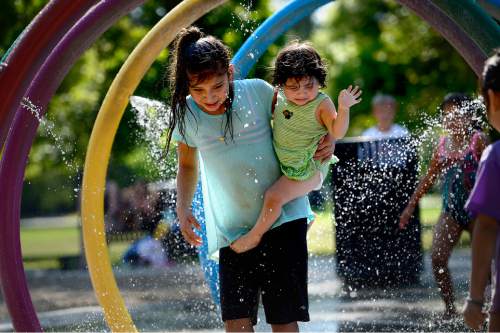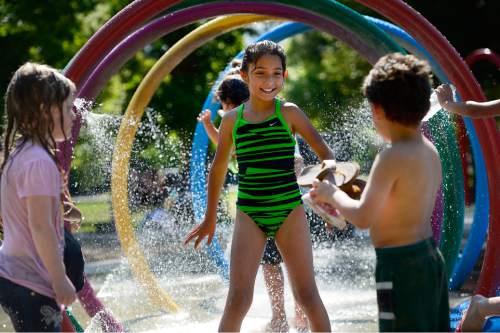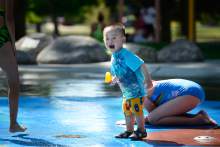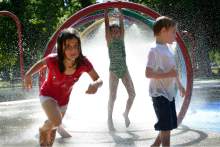This is an archived article that was published on sltrib.com in 2015, and information in the article may be outdated. It is provided only for personal research purposes and may not be reprinted.
Thermometers are not the only thing rising into the red this week.
The Salt Lake Valley's ozone pollution will spike into unhealthy levels most afternoons, due to the photochemical reactions that turn tailpipe emissions into the oxidizing gas under blistering sunshine.
Already this month, the monitoring station at Salt Lake City's Hawthorne Elementary School recorded ozone concentrations that exceeded the federal air quality standard nine times.
"Normally, our worst times are July and August," said Bo Call, monitoring chief for the Utah Division of Air Quality. "We haven't gotten [to July] yet, and we've already had plenty."
The U.S. Environmental Protection Agency's eight-hour limit was breached June 8, 9, 13, 18, 20, 23, 24, 27 and 28.
On Saturday, ozone skyrocketed to 102 parts per billion (ppb) by 1 p.m., fell that night, then peaked at 91 on Sunday afternoon. Monday registered a peak of 105 ppb at Hawthorne. And no lasting relief is in sight.
Ozone forecasts indicate "mandatory action" will apply to much of the Wasatch Front this week.
"We are asking employers to institute their trip-reduction plans," said Donna Spangler, spokeswoman for the Department of Environmental Quality. "We are asking you to limit driving, take mass transit."
Summertime ozone is unlike cold-weather inversions — the fine particulate pollution that clogs the winter sky.
Instead, ozone rises and falls in lockstep with solar movement. Hot-weather smog forms after nitrogen oxides and volatile organic compounds — common pollutants that come from engines — mix in the atmosphere. When they are baked under the sun, the "precursor" pollution gives up oxygen atoms, which recombine as three-atom molecules, as opposed to the life-giving, two-atom variety of oxygen.
"It essentially sunburns your lungs and causes inflammation," said Seth Arens, an environmental scientist with DAQ. "For the next three days, we are forecasting it to get in the unhealthy range and potentially violate the federal standard."
Last summer, the Wasatch Front logged decent air quality because persistent cool, cloudy weather thwarted ozone formation. The Salt Lake Valley's airshed currently meets the federal ozone rule, but it could fall out of attainment if this month's trend continues.
The eight-hour standard is currently set at 75 ppb. An airshed is out of attainment if its fourth-worst ozone value, averaged over three years, exceeds 75 ppb — a limit EPA regulators expect to lower to 70.
The standard is based on an eight-hour average, but afternoon spikes are what people should avoid to spare their respiratory systems from ozone's corrosive impact. State air quality watchdogs advise getting your outdoor exercise in the morning to be safe.
"For public health, [the eight-hour average] doesn't matter. If it's 80 ppb for that hour you're out walking your dog, it's going to affect you," said Arens, who is coordinating a new study of how the Great Salt Lake enhances ozone formation.
Ozone concentrations peak by midafternoon, soon after the sun reaches its zenith, then these corrosive molecules start to fall apart as the sun dips.
Ironically, auto emissions at night help dismantle ozone by throwing out nitrogen that plucks oxygen atoms from ozone molecules, rendering them harmless.
"Ozone in rural areas doesn't go down as much at night," Arens said, "because there aren't as many vehicles present."
But that nighttime exhaust is no friend to the atmosphere; its VOCs will start producing ozone again as soon as the sun rises.
Arens' lake study, conducted in partnership with scientists at the University of Utah, Weber State University and Utah State University, will measure the lake's effect on ozone formation in an effort to improve forecasting.
Study data, gathered with balloons and drones, already have identified interesting anomalies. On Monday, for instance, the highest ozone levels, exceeding 90 ppb, were recorded at Fremont Island, about 10 miles west of Roy in the middle of the lake, and Badger Island on the lake's western shore.
While nighttime ozone drops to a comfortable 20 ppb in Salt Lake City overnight, Fremont's ozone dips into the 30s, Arens said.















